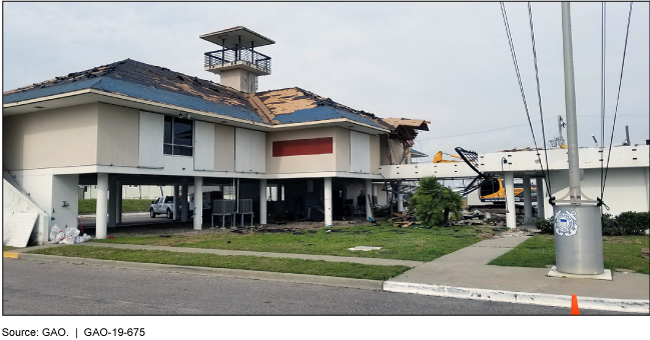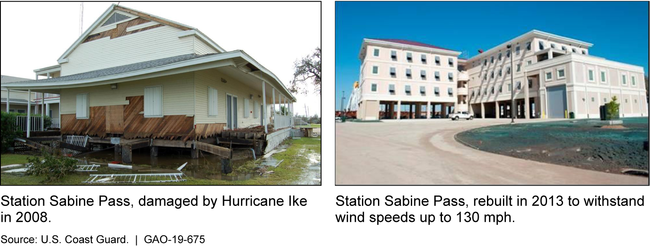Coast Guard Shore Infrastructure: Processes for Improving Resilience Should Fully Align with DHS Risk Management Framework
Fast Facts
The Coast Guard has more than 20,000 shore facilities—such as boat stations and piers—that are often vulnerable to damage from natural disasters such as hurricanes and earthquakes.
While the Coast Guard has improved some of its facilities to make them more resilient, it can do more to stay on top of the risk. For example, DHS’s guidance suggests prioritizing projects by how crucial the asset is to the mission. The Coast Guard, however, hasn’t assessed the majority of its infrastructure—including piers, which are mission critical.
We recommended that the Coast Guard improve how it assesses and prioritizes its resilience projects.
Hurricane Harvey damaged the Coast Guard station in Port Aransas, Texas, in 2017

A damaged Coast Guard station affected by Hurricane Harvey
Highlights
What GAO Found
Since 2005, the U.S. Coast Guard's main actions to improve resilience have been to repair or rebuild shore infrastructure to higher building standards after it has been damaged by extreme weather events. The Coast Guard has received more than $2 billion in supplemental appropriations since 2005 to improve resilience after severe storms (see figure). The Coast Guard has also developed new guidance requiring that repairs and new construction meet higher building standards to make it more resilient. Further, in 2015, the Coast Guard began an assessment of certain occupied buildings to identify their vulnerabilities to ten natural hazards, such as hurricanes and earthquakes. As of 2018, this assessment covered approximately 16 percent of the Coast Guard's shore infrastructure. The Coast Guard aims to complete the assessment in 2025.
Coast Guard Station Sabine Pass, Texas, Rebuilt to Be More Resilient in 2013

Coast Guard processes to improve shore infrastructure resilience do not fully align with the Department of Homeland Security's (DHS) key steps for critical infrastructure risk management. These steps are described in DHS's Critical Infrastructure Risk Management Framework, which recommends that DHS components, among other things, identify critical infrastructure, assess risks, and implement risk management activities. While the Coast Guard has identified some vulnerable shore infrastructure through its ongoing assessment, it has not identified all shore assets that may be vulnerable, such as piers and runways; or assessed operational risks affecting its ability to complete missions with these assets. In addition, the Coast Guard has not taken steps to develop mitigation strategies for buildings already identified as vulnerable. Moreover, Coast Guard data show a growing backlog of at least $2.6 billion in recapitalization, new construction, and deferred maintenance projects that compete for finite funding. However, Coast Guard officials were unable to verify that they have consistently selected projects to also enhance resilience. Coast Guard officials stated that they have not used the DHS framework and have instead focused on implementing their ongoing vulnerability assessment. Fully aligning its processes with the DHS framework would better position the Coast Guard to reduce its future fiscal exposure to the effects of extreme weather events.
Why GAO Did This Study
The Coast Guard, within DHS, owns or leases more than 20,000 shore facilities such as piers, boat and air stations, and housing units at over 2,700 locations. This infrastructure is often positioned on coastlines where it is vulnerable to damage from extreme weather. Noting the importance of protecting critical infrastructure from such risks, in 2013 DHS updated its risk management guidance for enhancing infrastructure resilience—which is the ability to prepare and plan for, absorb and recover from, or successfully adapt to adverse events.
GAO was asked to review Coast Guard efforts to improve the resilience of its shore infrastructure. This report (1) describes Coast Guard actions to improve shore infrastructure resilience since 2005, and (2) examines the extent to which its processes to improve shore infrastructure resilience follow DHS's key steps for critical infrastructure risk management. GAO reviewed and analyzed Coast Guard guidance and data on assessed infrastructure and interviewed Coast Guard officials. GAO also compared Coast Guard policies, procedures, and actions to manage shore infrastructure against DHS's framework for managing risks to critical infrastructure.
Recommendations
GAO recommends that the Coast Guard revise its processes for improving shore infrastructure resilience to more fully align with key steps of the DHS critical infrastructure risk management framework. This should include, for example, identifying critical infrastructure, assessing risks, and implementing risk management activities. DHS concurred with our recommendation.
Recommendations for Executive Action
| Agency Affected | Recommendation | Status |
|---|---|---|
| United States Coast Guard | The Commandant of the Coast Guard should ensure that the Deputy Commandant for Mission Support implements risk management processes that more fully align with the five key steps outlined in DHS's Critical Infrastructure Risk Management Framework to better guide agency shore infrastructure investment decisions. This should include (1) setting goals and objectives, (2) identifying critical infrastructure, (3) assessing and analyzing risks and costs, (4) implementing risk management activities, and (5) measuring the effectiveness of actions taken. (Recommendation 1) |
The U.S. Coast Guard is the principal federal agency charged with ensuring the security and safety of the high seas and other waters subject to U.S. jurisdiction. To help carry out its missions, the Coast Guard owns or leases more than 20,000 shore facilities-such as piers, boat stations, air facilities, and housing units-at more than 2,700 locations. However, this infrastructure is often positioned along the nation's coastlines and can be vulnerable to damage from extreme weather and other natural disasters, such as hurricanes, earthquakes, and tsunamis. For example, Coast Guard facilities along the East and Gulf coasts of the United States are vulnerable to hurricanes-which NOAA projects will increase in frequency and severity because of climate change and may cause flooding or wind damage to Coast Guard infrastructure. During audit work that we conducted from July 2018 to September 2019, we found that in 2015, the Coast Guard began an assessment of certain occupied buildings to identify their vulnerabilities to ten natural hazards, including hurricanes and earthquakes. While the Coast Guard had identified some vulnerable shore infrastructure through its ongoing assessment, it had not identified all shore assets that may be vulnerable, such as piers and runways; or assessed operational risks affecting its ability to complete missions with these assets. We reported that although the Coast Guard aimed to complete its assessment by 2025, the Coast Guard's assessment had only covered approximately 16 percent of the Coast Guard's shore infrastructure as of 2018. We also found that Coast Guard processes to improve shore infrastructure resilience did not fully align with the Department of Homeland Security's (DHS) key steps for critical infrastructure risk management-steps described in DHS's Critical Infrastructure Risk Management Framework, which recommends that DHS components, among other things, identify critical infrastructure, assess risks, and implement risk management activities. Moreover, at the time of our review, Coast Guard data showed a growing backlog of at least $2.6 billion in recapitalization, new construction, and deferred maintenance projects that compete for finite funding. However, Coast Guard officials were unable to verify that they have consistently selected projects to also enhance resilience. Coast Guard officials stated that they had not used the DHS framework and instead focused on implementing their ongoing vulnerability assessment. As a result of our audit work, the Coast Guard undertook steps to ensure that the Deputy Commandant for Mission Support implemented risk management processes that more fully align with the five key steps outlined in DHS's Critical Infrastructure Risk Management Framework to better guide agency shore infrastructure investment decisions. For example, in September 2019, the Coast Guard published its Component Plan for Resilience which established a Resilience Planning Committee and prioritizes identifying resilience gaps and potential solutions among other priorities. The Coast Guard also published its Civil Engineering Work Plan in Fiscal Year 2021 that includes among other things, two priorities that specifically focus on shore infrastructure resilience. Furthermore, in support of its stated goals to strategically incorporate resilience into shore infrastructure planning the Coast Guard published engineering design guidance intended to ensure that the Coast Guard's buildings and some key supporting infrastructure such as waterfront structures and utilities are resilient. Taken together, these efforts represent notable steps toward identifying risk management activities that, when completed, could help promote a more resilient shore infrastructure program that is more closely aligned with the DHS framework and better positions the Coast Guard to reduce its future fiscal exposure to the effects of extreme weather events.
|
